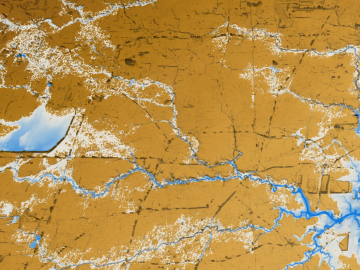
Filter News
Area of Research
- (-) National Security (19)
- (-) Supercomputing (74)
- Advanced Manufacturing (8)
- Biological Systems (2)
- Biology and Environment (96)
- Biology and Soft Matter (1)
- Computational Engineering (2)
- Computer Science (6)
- Electricity and Smart Grid (3)
- Energy Frontier Research Centers (1)
- Energy Science (122)
- Functional Materials for Energy (2)
- Fusion and Fission (10)
- Fusion Energy (8)
- Isotopes (4)
- Materials (147)
- Materials Characterization (2)
- Materials for Computing (15)
- Materials Under Extremes (1)
- Mathematics (1)
- Neutron Science (40)
- Nuclear Science and Technology (14)
- Nuclear Systems Modeling, Simulation and Validation (1)
- Quantum information Science (3)
- Sensors and Controls (1)
News Topics
- (-) Advanced Reactors (2)
- (-) Big Data (25)
- (-) Bioenergy (11)
- (-) Grid (11)
- (-) Materials (16)
- (-) Microscopy (7)
- (-) Nanotechnology (11)
- (-) Physics (9)
- 3-D Printing/Advanced Manufacturing (7)
- Artificial Intelligence (46)
- Biology (14)
- Biomedical (17)
- Biotechnology (3)
- Buildings (4)
- Chemical Sciences (5)
- Computer Science (105)
- Coronavirus (16)
- Critical Materials (3)
- Cybersecurity (23)
- Energy Storage (9)
- Environment (26)
- Exascale Computing (26)
- Frontier (32)
- Fusion (2)
- High-Performance Computing (45)
- Isotopes (2)
- Machine Learning (24)
- Materials Science (17)
- Mathematics (2)
- Molten Salt (1)
- National Security (36)
- Neutron Science (15)
- Nuclear Energy (8)
- Partnerships (5)
- Polymers (2)
- Quantum Computing (20)
- Quantum Science (26)
- Security (15)
- Simulation (16)
- Software (1)
- Space Exploration (3)
- Summit (43)
- Transportation (8)
Media Contacts

A study led by researchers at ORNL used the nation’s fastest supercomputer to close in on the answer to a central question of modern physics that could help conduct development of the next generation of energy technologies.

Neuromorphic devices — which emulate the decision-making processes of the human brain — show great promise for solving pressing scientific problems, but building physical systems to realize this potential presents researchers with a significant

A world-leading researcher in solid electrolytes and sophisticated electron microscopy methods received Oak Ridge National Laboratory’s top science honor today for her work in developing new materials for batteries. The announcement was made during a livestreamed Director’s Awards event hosted by ORNL Director Thomas Zacharia.

An international problem like climate change needs solutions that cross boundaries, both on maps and among disciplines. Oak Ridge National Laboratory computational scientist Deeksha Rastogi embodies that approach.

At the Department of Energy’s Oak Ridge National Laboratory, scientists use artificial intelligence, or AI, to accelerate the discovery and development of materials for energy and information technologies.

Since the 1930s, scientists have been using particle accelerators to gain insights into the structure of matter and the laws of physics that govern our world.

A new tool from Oak Ridge National Laboratory can help planners, emergency responders and scientists visualize how flood waters will spread for any scenario and terrain.

Six scientists at the Department of Energy’s Oak Ridge National Laboratory were named Battelle Distinguished Inventors, in recognition of obtaining 14 or more patents during their careers at the lab.

The annual Director's Awards recognized four individuals and teams including awards for leadership in quantum simulation development and application on high-performance computing platforms, and revolutionary advancements in the area of microbial

A multi-institutional team, led by a group of investigators at Oak Ridge National Laboratory, has been studying various SARS-CoV-2 protein targets, including the virus’s main protease. The feat has earned the team a finalist nomination for the Association of Computing Machinery, or ACM, Gordon Bell Special Prize for High Performance Computing-Based COVID-19 Research.


